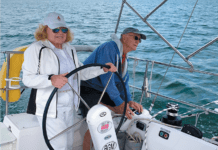Build Your Own Fender Boards
Fender boards are almost a necessity when docking against pilings because without them, no matter how you position and secure your boat and fenders, movement of tide and boat will displace the position of the fenders relative to the piles.The result dinged topsides.
Fender boards, designed to ride outboard of two fenders, protect a much larger section of topsides much more effectively.
The simplest form of fender board is adequate for most needs.All that is needed is a 3- to 4-foot length of 2 x 4, 2 x 6, or 2 x 8 inches. As a guide, Id start at 2 x 4 for a 20-foot boat, a 2 x 6 for a 30-footer, and a 2 x 8 for a 40-footer.
On a larger boat, you may want to use a slightly longer board, perhaps up to 6 feet long.Anything longer than that, however, is likely to take two people to handle, and be a nuisance to store.
Just go the lumberyard and get normal dimension lumber, which may be any variety of softwood. Make sure that it doesn’t have any large knots in the middle of the board which might cause it to break under heavy loading. A hardwood like ash will take more abuse, but the extra weight can make it a handful for one person to handle.
A hole slighty larger than the diameter of the suspension or drop lines (say 9/16-inch hole for a -inch line), is drilled through the larger dimension at either end of the board, about 6 feet from either end.
Next, round the ends of the plank and chamfer all edges. Your lines should be long enough to suspend the plank down to the waterline from whatever stanchions or cleats you plan to use.
After threading the lines through the holes, tie a figure-8 stopper knot at the bottom of each line, and youre finished.
Because of the abuse fender boards are intended to take, painting or varnishing them is pretty much a waste of time.And, because you want a fender board to be as gentle as possible to your boat, complications like metal hanging straps or eye bolts are best avoided.
You can use your fender board with conventional round fenders, or you can purchase solid rubber cushions made specifically for attaching to 2 x 4 or 2 x 6 spars.Made by Taylor, they are available though most retail chandlers and mail order forms. In our experience they do not give the board quite as much standoff from the hull that a large round fender will, but because they are permanently attached to fender board, there is no risk that they will pop out of position, allowing the board to rest- and rub- against the topsides of your board.
The one embellishment you might wish to consider, if you have sufficient time and/or inclination, is a laminated fender board.This board is composed of three layers of 1 x 3-inch fir, hickory, or ash with the layers separated by 1/8-inch strips of wood epoxied in at either end with the object of creating a leaf-spring effect.I saw one of these years ago, and, though I don’t imagine its much more effective than a length of solid 2 x 6, it certainly looked impressive and showed a certain pride of ownership that a simpler board would lack.Only you can decide which sort of board would satisfy you.
For more than 1,000 tips, suggestions, evaluations, and nuggets of hard-won advice from more than 300 seasoned veterans, purchase Sailors’ Secrets: Advice from the Masters today!





































